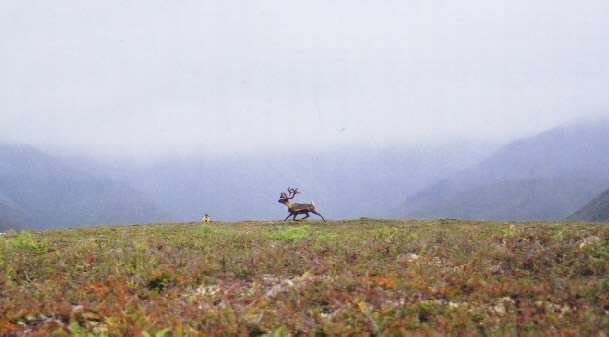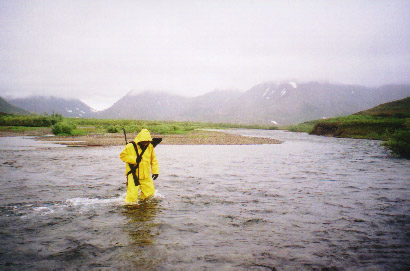Alaska Diary: Day 2, September 1, 2001
 The day was damp, cool and cloudy. We took our time getting out of the tent and had a mid-morning breakfast. Norm ate what he ate every morning of the trip: his own mixture of mini-shredded wheat mixed with various dried fruits and moistened with a little ½ pint box of soy milk. I alternated between granola and oatmeal during the trip. He drank green tea and I had Starbucks coffee made in a plastic coffee press.
The day was damp, cool and cloudy. We took our time getting out of the tent and had a mid-morning breakfast. Norm ate what he ate every morning of the trip: his own mixture of mini-shredded wheat mixed with various dried fruits and moistened with a little ½ pint box of soy milk. I alternated between granola and oatmeal during the trip. He drank green tea and I had Starbucks coffee made in a plastic coffee press.
 We had noticed several caribou on the next ridge and we decided to walk down the bank of the river, ascend the steep ridge and try to sneak up on them for a close photo. Carrying our guns (Mossberg 12 g. bolt-action shotgns with rifled barrels and loaded with 2 ¾" Winchester Partition Gold 1 oz. Slugs), waterproof PVC Gunboat gun cases and wearing our hip waders, we tried this only to find that the caribou had seen us and had moved back out of sight. I thought they had just moved back from the edge of the ridge. When we had climbed a little higher, we saw their racks sticking up. The racks are huge, so big that we could see them without the caribou seeing us. Norm decided he would circle around and try to drive them toward me so that I could get a good close-up shot. But when Norm stood up the group divided and went east west when our plan had been to drive them south. We got a couple of long-range shots.
We had noticed several caribou on the next ridge and we decided to walk down the bank of the river, ascend the steep ridge and try to sneak up on them for a close photo. Carrying our guns (Mossberg 12 g. bolt-action shotgns with rifled barrels and loaded with 2 ¾" Winchester Partition Gold 1 oz. Slugs), waterproof PVC Gunboat gun cases and wearing our hip waders, we tried this only to find that the caribou had seen us and had moved back out of sight. I thought they had just moved back from the edge of the ridge. When we had climbed a little higher, we saw their racks sticking up. The racks are huge, so big that we could see them without the caribou seeing us. Norm decided he would circle around and try to drive them toward me so that I could get a good close-up shot. But when Norm stood up the group divided and went east west when our plan had been to drive them south. We got a couple of long-range shots.
 I then saw a group of caribou on the other side of the river and we waded across the very clear and cold river and spent some time tracking them. Our outfitter had told us they were unpredictable and it seemed that they did move in a random motion. We would guess that they were moving up a valley and try to circle around only to find that they were on top of the next ridge. I suppose they evolved this random motion to fend off predators; a predictable caribou would not last long among bears and wolves--not to mention modern day hunters.
I then saw a group of caribou on the other side of the river and we waded across the very clear and cold river and spent some time tracking them. Our outfitter had told us they were unpredictable and it seemed that they did move in a random motion. We would guess that they were moving up a valley and try to circle around only to find that they were on top of the next ridge. I suppose they evolved this random motion to fend off predators; a predictable caribou would not last long among bears and wolves--not to mention modern day hunters.
 Through binoculars we learned to differentiate males and females and younger offspring. The head bull spent much of his time watching while the rest of the herd ate. We also noticed differences in the sexes. The males were darker, an almost blackish brown. The females were grayer. The young ones have very small spiky racks while both male and female have huge ones. These antlers also varied in color. They were red just after the velvet was shed, then an intermediate stage of yellow and then gray. We saw all these stages at once. Each individual had its own schedule.
Through binoculars we learned to differentiate males and females and younger offspring. The head bull spent much of his time watching while the rest of the herd ate. We also noticed differences in the sexes. The males were darker, an almost blackish brown. The females were grayer. The young ones have very small spiky racks while both male and female have huge ones. These antlers also varied in color. They were red just after the velvet was shed, then an intermediate stage of yellow and then gray. We saw all these stages at once. Each individual had its own schedule.
 In the middle of our caribou study we suddenly heard a motor and saw a red helicopter coming up the river, following every bend. It spun around when it saw the herd of caribou we were watching. The caribou ran up a farther ridge. Then it continued up to the lake and swung around and made a faster straight line back down the river. It broke the spell and we headed back to our camp for lunch.
In the middle of our caribou study we suddenly heard a motor and saw a red helicopter coming up the river, following every bend. It spun around when it saw the herd of caribou we were watching. The caribou ran up a farther ridge. Then it continued up to the lake and swung around and made a faster straight line back down the river. It broke the spell and we headed back to our camp for lunch.
 After lunch rain began and we headed for the tent. We ended staying there until suppertime at 8:00 or 8:30. It seemed to get much colder. We dozed, talked and read. Our pilot flew back and dropped a group of four women on the other side of the lake. We had heard they were coming and knew that they were just going to camp, not float the river. We came out of the tent to see what was going on; but it was so miserable that we just peeled our clothes off and jumped back in. We awoke many times during the night to hear wind and rain.
After lunch rain began and we headed for the tent. We ended staying there until suppertime at 8:00 or 8:30. It seemed to get much colder. We dozed, talked and read. Our pilot flew back and dropped a group of four women on the other side of the lake. We had heard they were coming and knew that they were just going to camp, not float the river. We came out of the tent to see what was going on; but it was so miserable that we just peeled our clothes off and jumped back in. We awoke many times during the night to hear wind and rain.

